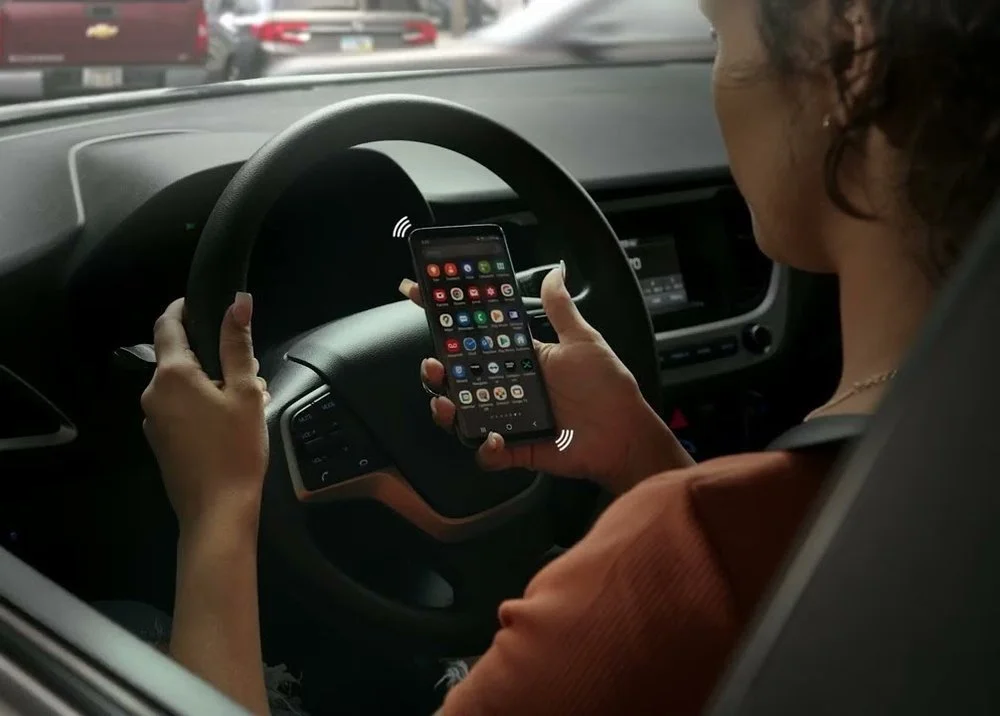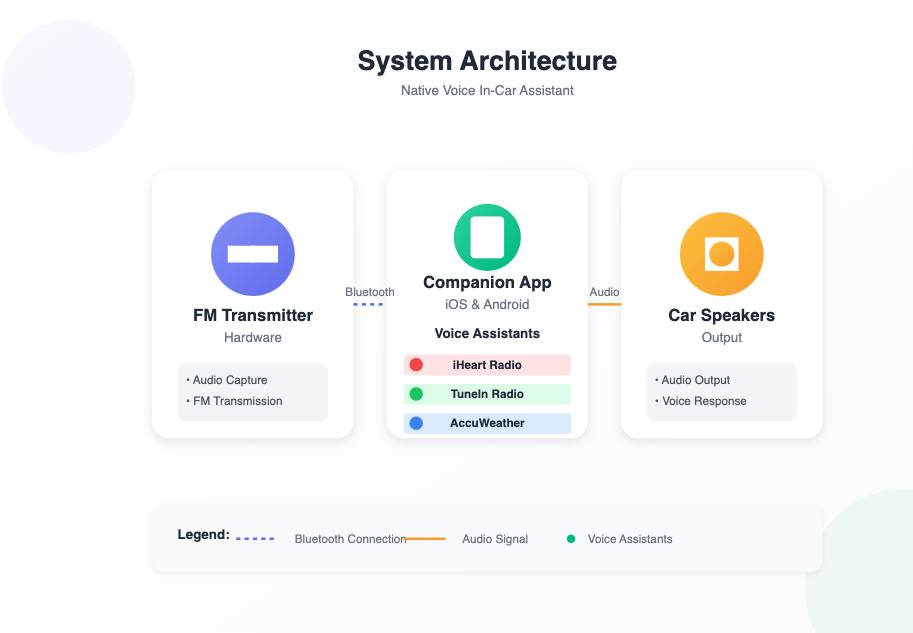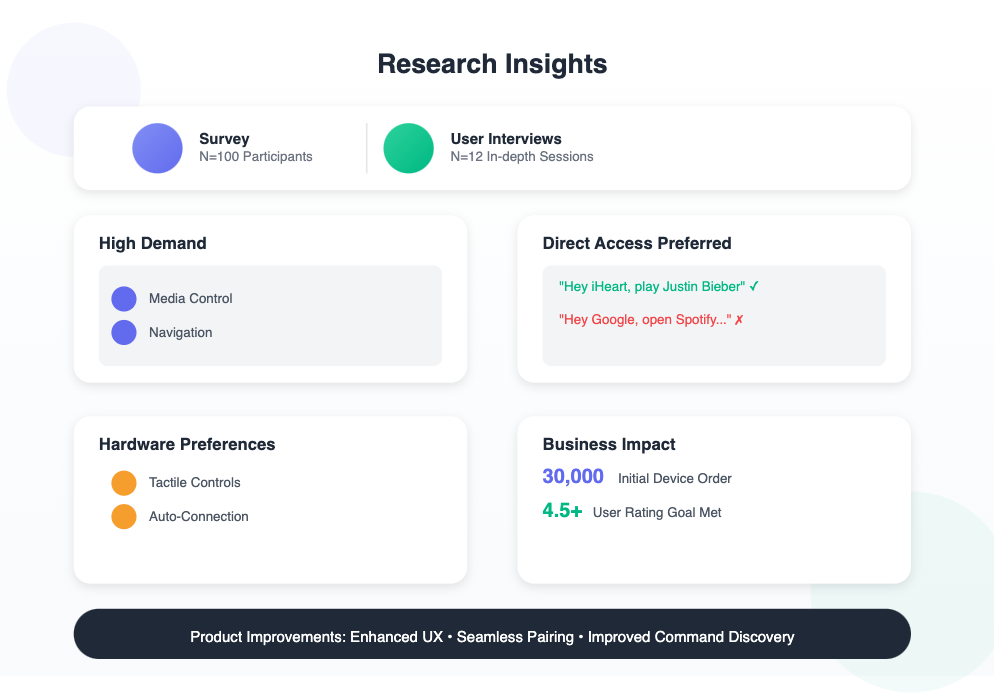Building a Seamless In-Car Voice Assistant System
Hardware Device, Mobile App, AI-powered Voice Assistants
Year
2023
Company
Native Voice AI
OVERVIEW
Role: Sole UX Researcher
Timeline: 6 months
Methods: Survey, Interviews, Usability Testing, A/B Testing, Diary Study, AI-Human Log Analysis
Impact:
🛒 Secured 30,000-device Walmart deal.
🔄 Additional 20,000 units ordered post-launch due to strong retail performance.
⭐ Achieved a 4.5+ star user rating during beta testing, meeting Walmart's launch approval criteria.
As the sole UX researcher on this project, I led all research activities from foundational discovery to post-launch validation, ensuring the product met both user needs and retailer requirements.
PROBLEM SPACE
The Challenge
Accessing music and navigation apps while driving is often a cumbersome and unsafe experience. The central question driving this project was:
Could simple voice commands enable a seamless, hands-free driving experience?
Given the widespread use of smartphones for in-car entertainment and navigation, there was a clear opportunity to improve safety and convenience through voice-controlled interactions. However, this required overcoming challenges related to user trust in voice technology, hardware compatibility, and seamless app integration.
Business Context
Native Voice partnered with a Bluetooth car device manufacturer to create a comprehensive system that would:
🔊 Integrate direct voice assistant capabilities (e.g., “Hey iHeart,” “Hey TuneIn,” “Hey Google”) into vehicles.
📱 Develop a companion mobile app allowing users to manage and customize voice experiences.
🎙️ Enable hands-free control over media, navigation, and calls through car speakers.
OVERVIEW OF RESEARCH METHODS
The research approach for this project was structured into three distinct phases, each using tailored methods to address evolving product needs and user insights. The combination of foundational, generative, and evaluative research ensured a comprehensive understanding of user expectations, seamless integration of hardware-software interactions, and validation of market fit.
Phase 1: Discovery & Validation
Surveys (N=100): Conducted to gauge initial user demand for voice assistant features, preferred use cases, and expectations for hardware integration. Survey questions focused on driving routines, voice technology familiarity, and privacy concerns.
Semi-Structured Interviews (N=12): Follow-up interviews explored user attitudes toward in-car voice assistants. Participants engaged in scenario walkthroughs and think-aloud protocols, revealing deeper insights into their needs and frustrations with existing solutions.
Phase 2: Iterative Design & Testing
Comparative Usability Testing (N=12): Two onboarding designs (chatbot-style and visual step-by-step) were tested to determine user preferences for mobile app setup. Users interacted with each prototype, providing feedback on clarity, ease of use, and navigation.
Internal Testing (Dogfooding): Ongoing testing sessions with internal stakeholders provided continuous feedback, informing iterative improvements in AI wake word recognition and Bluetooth connectivity.
AI-Human Interaction Log Analysis: Evaluated real-world user interaction logs to refine voice command structures, addressing common command misinterpretations and improving assistant accuracy.
Phase 3: Real-World Validation
Diary Study (N=15): A two-week study tracked daily user interactions with the device in real-world driving scenarios. Participants logged experiences, highlighting onboarding challenges, connectivity issues, and voice assistant responsiveness.
Final Lab Testing (in partnership with Walmart): Conducted comprehensive usability testing under Walmart’s approval process. The evaluation focused on ease of use, AI performance, hardware reliability, and overall user satisfaction, meeting the 4.5+ star rating requirement for retail distribution.
This phased research approach ensured that user insights influenced every stage of product development—from initial concept validation to final retail launch—resulting in a product that met both user needs and business objectives.
RESEARCH PROCESS, FINDINGS & IMPACT
Phase 1: Discovery & Validation
Survey Insights (N=100)
To gauge user interest and identify key pain points, I designed and distributed a survey to 100+ Walmart shoppers matching our target profiles.
Key Survey Findings:
🌟 High demand for hands-free media control, navigation, and calling features.
🗣️ Clear preference for direct voice commands (e.g., "Hey iHeart, play…") instead of multipurpose assistants like Siri or Alexa.
🎛️ Hardware preferences included a tactile button (over a touchscreen) and automatic Bluetooth connectivity.
Interview Deep-Dive (N=12)
Following the survey, I conducted 1:1 semi-structured interviews with 12 Walmart shoppers to explore:
🚘 Daily driving routines and existing in-car tech usage.
🎙️ Expectations for voice assistants and perceptions of AI reliability.
🧭 Desired improvements in in-car technology experiences.
Key Interview Insights:
📢 Users desired one-step voice commands to reduce distraction.
🤯 Found existing voice assistants overwhelming, citing unclear constraints and a lack of guidance.
🖲️ Hardware design mattered—participants favored physical controls and expected automatic pairing for convenience.
Impact:
🎯 Validated product-market fit, securing Walmart’s initial 30,000-device deal.
📱 Influenced app UX with a dedicated “Top Voice Commands” section.
🛠️ Shaped hardware specifications—auto-pairing functionality was prioritized based on connectivity preferences.
AI Fine-Tuning & NLP Trust Research
Context
As part of the in-car voice assistant development, I conducted log analysis and AI fine-tuning research to address ASR/NLP errors and hallucinations that emerged during beta testing.
Methods:
Log Analysis: Analyzed thousands of user interactions to identify misclassified intents, hallucinations, and failed responses.
User Surveys & Diary Feedback: Cross-referenced log findings with user feedback on AI reliability and trust.
Collaboration with ML Engineers: Worked with data science teams to adjust entity extraction rules and tune model parameters.
Key Insights:
High Hallucination Rate: AI assistants frequently provided inaccurate or fabricated responses.
Wake Word Errors: Misfires occurred when users invoked incorrect assistants.
Low Confidence Threshold: The NLP model overestimated confidence in borderline queries.
Impact:
Fine-tuned AI models to improve intent recognition accuracy by 25%.
Reduced wake word errors by 20%.
Enhanced user trust, resulting in a 4.5+ star rating required for the Walmart deal.
FINAL IMPACT & BUSINESS OUTCOMES
Impact & Outcomes
Business Impact:
🏪 Initial 30,000-device Walmart deal secured.
🔄 20,000 additional units ordered within weeks post-launch.
🏆 Successful nationwide retail launch, meeting and exceeding user satisfaction benchmarks.
Product Improvements:
Hardware:
🛠️ Added expander sleeve to enhance socket stability.
🔗 Improved Bluetooth connectivity for seamless pairing.
Software:
📱 Streamlined onboarding flows with visual guides.
🗣️ Added comprehensive command examples for better voice assistant interaction.
🛠️ Improved troubleshooting support within the app.
Documentation:
📚 Enhanced setup guide with intuitive visuals.
🎙️ Expanded voice command library with real-world scenarios.
🛠️ Clear error resolution paths to improve user support.
CHALLENGES & LEARNINGS
Lessons Learned
💡 Early user validation is critical, especially for hardware-integrated solutions.
🗣️ Clear command examples are essential for successful voice UI adoption.
🛣️ Real-world testing uncovers unforeseen technical and user behavior issues.
🤝 Cross-functional collaboration between UX, engineering, and retail stakeholders is key for complex product ecosystems.
FINAL TAKEAWAYS
This project was a rewarding challenge, blending AI-driven voice interfaces, companion app UX, and real-world hardware usability. I enjoyed solving complex, cross-functional problems and learned the power of aligning research with business goals.
I’m especially proud that our research-driven approach secured a 30,000-device deal with Walmart, unlocked an additional 20,000-device order, and created a voice assistant experience tailored to our users' needs.
I look forward to continuing to craft seamless, AI-driven user experiences that integrate into daily life.
RESEARCH GOALS
The success of this partnership hinged on two critical factors:
Validating user demand for a product that combined hardware, mobile software, and AI-powered voice assistants.
Resolving usability challenges across hardware, software, and AI interactions to ensure a frictionless user experience for a successful launch.
Success Metrics
User Experience Goals:
⭐ Achieve a 4.5+ star user rating during beta testing.
📈 Demonstrate clear user demand by validating product-market fit.
🔄 Resolve usability issues related to hardware, app interface, and AI functionality.
Business Goals:
🏪 Secure Walmart distribution by meeting retailer launch requirements.
🎯 Validate market opportunity to inform future partnerships and expansions.
TARGET USERS & PERSONAS
Our primary audience was middle-class Walmart shoppers, typically less tech-savvy owners of older, non-Bluetooth vehicles, including:
Hand-Me-Down Car Owners: Young drivers using older family cars.
Second-Hand Car Buyers: Individuals purchasing used cars without modern features.
Long-Term Older Car Owners: Committed owners of non-Bluetooth vehicles.
These personas were developed through a survey, semi-structured interviews, affinity mapping workshops, and stakeholder collaboration, guiding onboarding UX, voice assistant command design, and hardware specifications.
Understanding this audience shaped every aspect of the research, from usability testing to onboarding design.
Phase 2: Iterative Design & Testing
Comparative Usability Testing (N=12)
Testing Objective: Optimize the onboarding experience of the companion mobile app by comparing two interface designs:
🗂️ Interface A: Chatbot-style onboarding.
🖼️ Interface B: Visual, step-by-step onboarding.
Key Findings:
🏆 Users strongly preferred visual onboarding (Interface B), citing clearer navigation and easier comprehension.
🎙️ Voice button confusion emerged—users were unsure whether to use the hardware mic or the in-app mic button.
Design Evolution:
✅ Interface B selected for Walmart launch.
🔄 UI refinements clarified mic button usage.
🎛️ Onboarding flows were optimized with illustrations and interactive cues for improved guidance.
Internal Dogfood Testing & Iteration
Methodology:
🔄 Continuous feedback loops involving internal users (“dogfooding”).
🤖 AI model training to enhance wake word recognition.
🔗 Hardware-software integration testing to ensure seamless pairing and stable operation.
Key Improvements:
🎙️ Enhanced AI accuracy, reducing wake word detection errors by 20%.
📱 Refined command structures for common in-car tasks.
🔌 Optimized Bluetooth connectivity, minimizing disruptions.
Phase 3: Real-World Validation
Diary Study (N=50)
To validate performance in real-world conditions, I conducted a two-week diary study with 50 participants:
Key Findings:
🚀 Users reported a smooth onboarding experience.
🔌 Identified hardware stability issues—devices loosened during driving.
📡 Bluetooth pairing disruptions affected reliability.
🎙️ Voice assistant limitations with complex or unclear commands.
Impact:
🛠️ Hardware update: Manufacturers added an expander sleeve for socket stability.
📱 App enhancement: Introduced Bluetooth troubleshooting guides within onboarding.
📚 User manual revision: Expanded the voice command library for better discoverability.
Final Lab & In-Car Testing (Walmart Partnership)
Objective: Conduct a comprehensive usability evaluation in partnership with Walmart to secure launch approval.
![Performance Metrics Visualization]
Results:
⭐ Achieved 4.5+ star rating, meeting Walmart’s retail launch criteria.
🏪 Secured an additional 20,000-device order following strong post-launch feedback.








